Introduction -------------------------------- 2-3 Scope ---------------------------------- 4-6 Objectives --------------------------------- 6-7 Definition of Terms ---------------------- 8-9 Recycling Procedural -------------------10-45 Appendices -------------------------------- 46 Labels for Bins ------------------- 46 Plastic Codes --------------------- 47 Safety and Best Practices – 48-50 References --------------------------------- 51-60
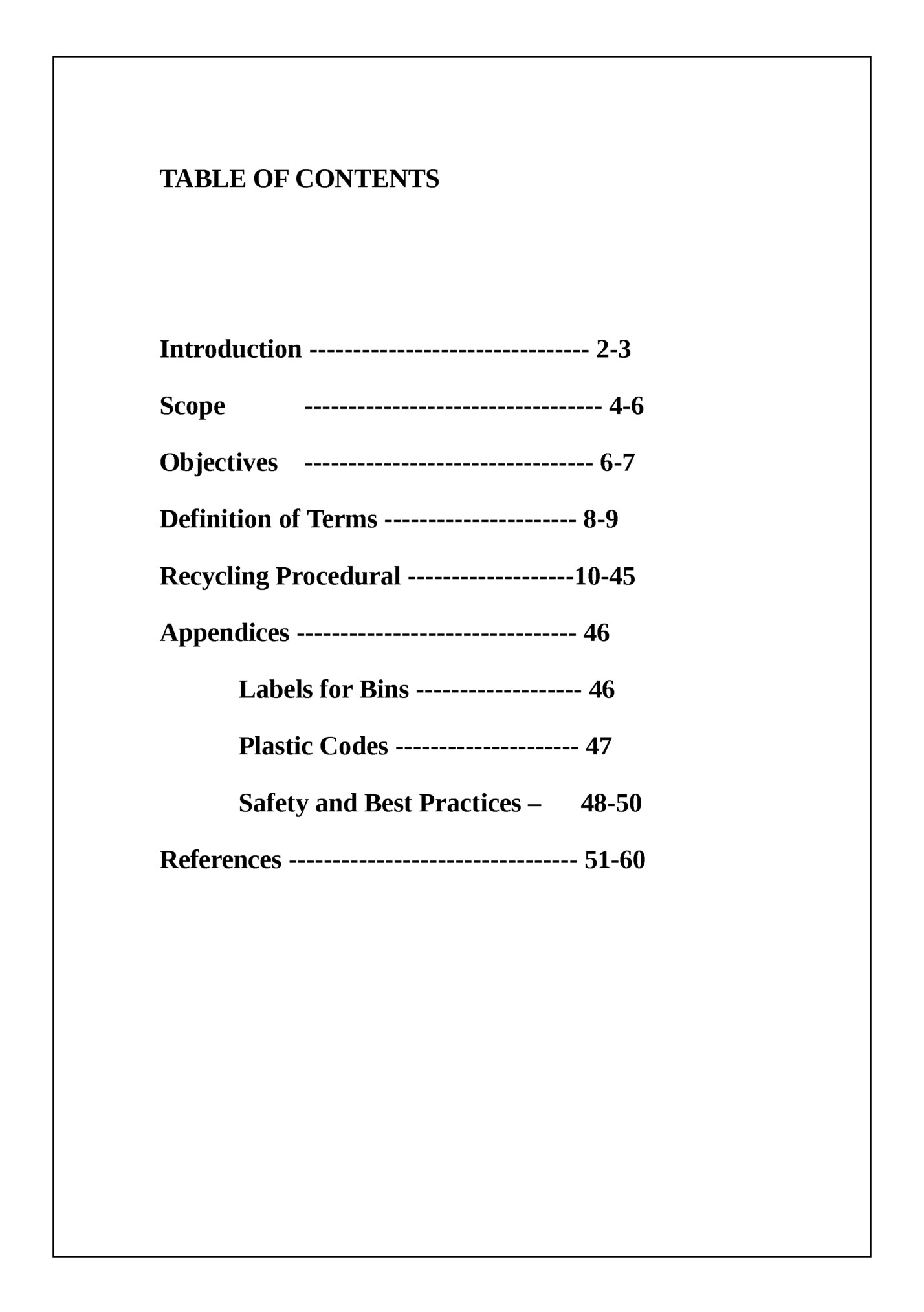
INTRODUCTION WHY THE MANUAL EXIST The Recycling Manual for Circular Economy in Each Type of Plastic (PET, HDPE, LDPE, and PP) functions as an operative handbook that supports sustainable circular plastic management. The document emerged because plastic pollution continues to grow globally together with increasing demands for efficient resource utilization and material cycling of common industry and household plastics. The most prominent plastics utilized in the packaging, consumer goods, and industrial materials environment (e.g., plastics such as PET (Polyethylene Terephthalate), HDPE (High-Density Polyethylene), LDPE (LowDensity (Polyethylene), and PP (Polypropylene)) (Plastic Pollution Blogger, 2024). It’s true that these materials can’t be beat in terms of ease of use and functionality but they haven’t been properly disposed of and unfortunately have such a low recycling rate that they have done massive amounts of environmental damage, from marine pollution to greenhouse gas emissions associated with virgin plastic production.
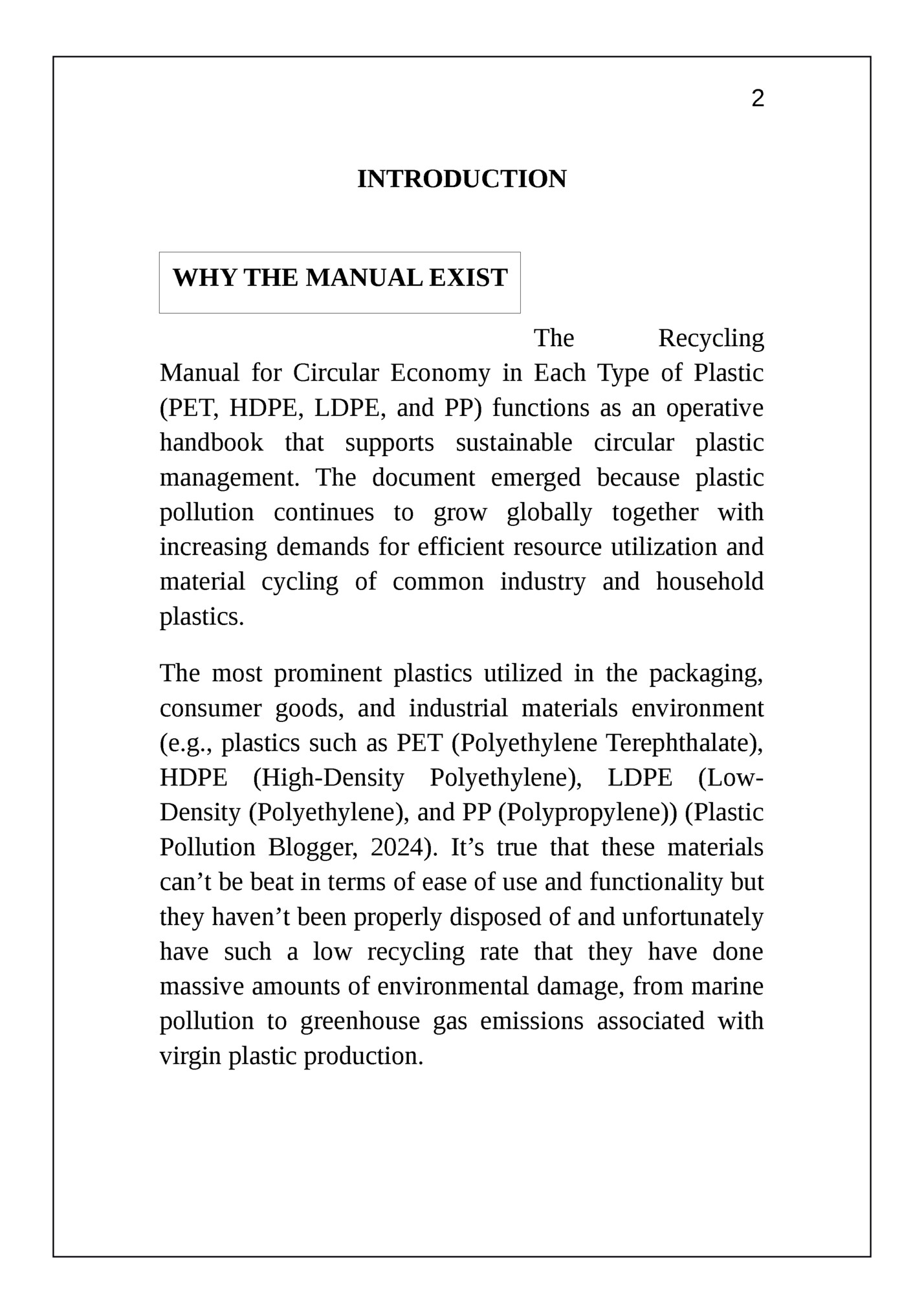
ENVIRONMENTAL AND INSTITUTIONAL IMPORTANCE From an environmental perspective, this manual places a great emphasis on improving waste management systems and reducing plastics dependence and promoting the reuse and reintroduction of materials into the economy (Alaghemandi, 2024). On the institutional level, it provides a basis for policymaking, businesses, recyclers, and communities to move towards national and international standards and principles of sustainable development and circular economy. SUSTAINABILITY POLICY This guide is also closely aligned with global sustainability goals, particularly the United Nations Sustainable Development Goals (SDGs), including: • SDG 12: Responsible Consumption and Production • SDG 13: Climate Action • SDG 14: Life Below Water • SDG 17: Partnerships for the Goals
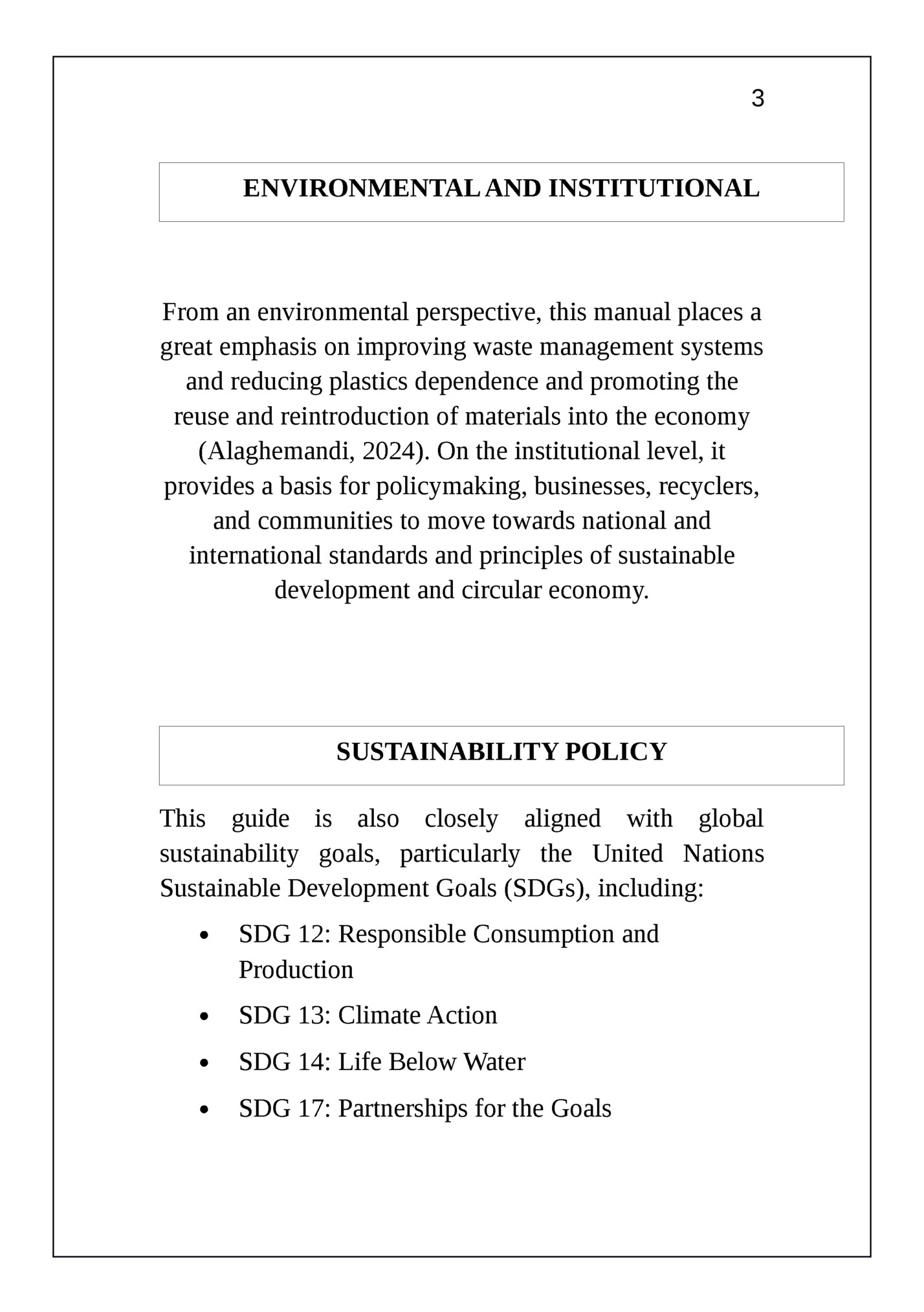
This manual is written for providing clear, actionable, and material-specific guidance to help achieve better recycling practices and longer term resource sustainability in line with environmental policies and circular economy strategies. Together, this awareness and standardized methods of plastic recovery and reuse can be further applied towards moving towards a circular system that serves both people and the planet. SCOPE As guidance for the design of policies towards the management, processing and disposal of plastic waste, this Recycling Manual is intended as an allencompassing Manual of stakeholders dealing with plastic waste management, processing and disposal. It outlines the properties, recycling, and best practices needed to increase circularity of four types of plastic used in most sectors. Who the Manual Applies To:

This manual is intended for a broad range of users, including but not limited to: • Government and policy makers involved in environmental regulations, waste management, and sustainability initiatives. • Recycling companies and waste management operators seeking to improve sorting, processing, and up cycling practices for plastics. • Manufacturers and producers of plastic products who aim to incorporate recyclability and circular design into their operations. • Local governments and municipalities managing community-level waste collection and recycling infrastructure. • NGOs, advocacy groups, and educators promoting public awareness and behavioral change in waste segregation and recycling. • Academic and research institutions studying material recovery, lifecycle assessment, and environmental impact.

Where the Procedures Apply: The procedures and guidelines outlined in this manual apply to all stages of the plastic recycling value chain, including: • Household and commercial waste collection systems • Material recovery facilities (MRFs) • Plastic sorting and processing plants • Product design and manufacturing facilities incorporating recycled content • Community and institutional recycling programs • Policy implementation frameworks at local, regional, and national levels OBJECTIVES This Recycling Manual for Circular Economy in Each Type of Plastic (PET, HDPE, LDPE, and PP) aims to: A. Promote Proper Management Plastic Waste
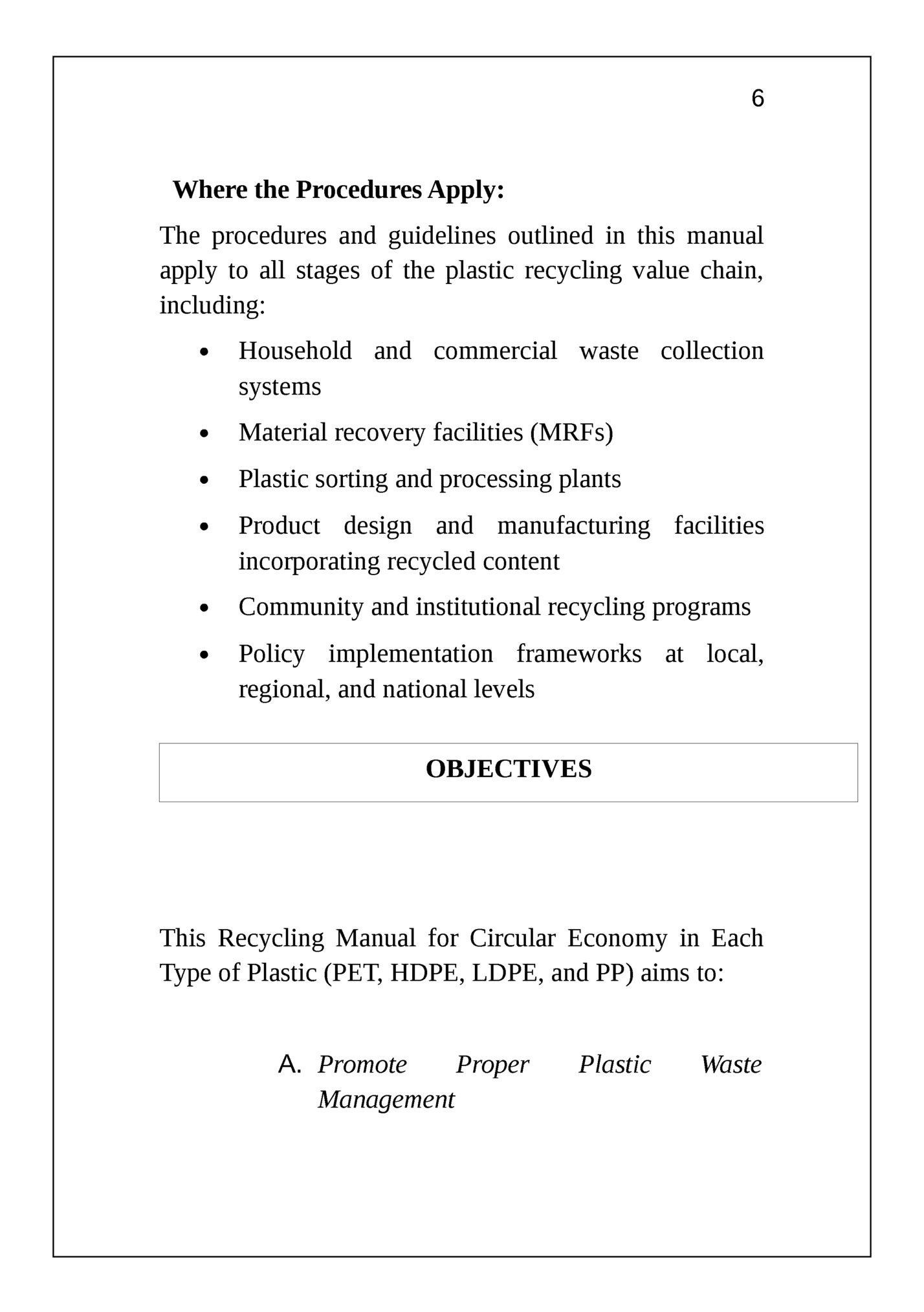
Set up clear guidelines on how to collect, separate, recycle and reuse PET, HDPE, LDPE and PP plastic to enable waste plastic handling in an efficient and responsible way by all sectors. B. Minimize environmental impact Recycling, diverting from landfill use, preventing plastic pollution from a source to a marine and terrestrial environment, by reducing greenhouse gas emission caused by production of virgin plastic. C. Encourage awareness and behavioral change Encourage a cultural change in plastic types and the recycling methods; stimulate individual, community, and institutional participation in waste reduction and practice the circular economy. DEFINITION OF TERMS To ensure clarity and consistency, the following key terms used in this manual are defined as follows:
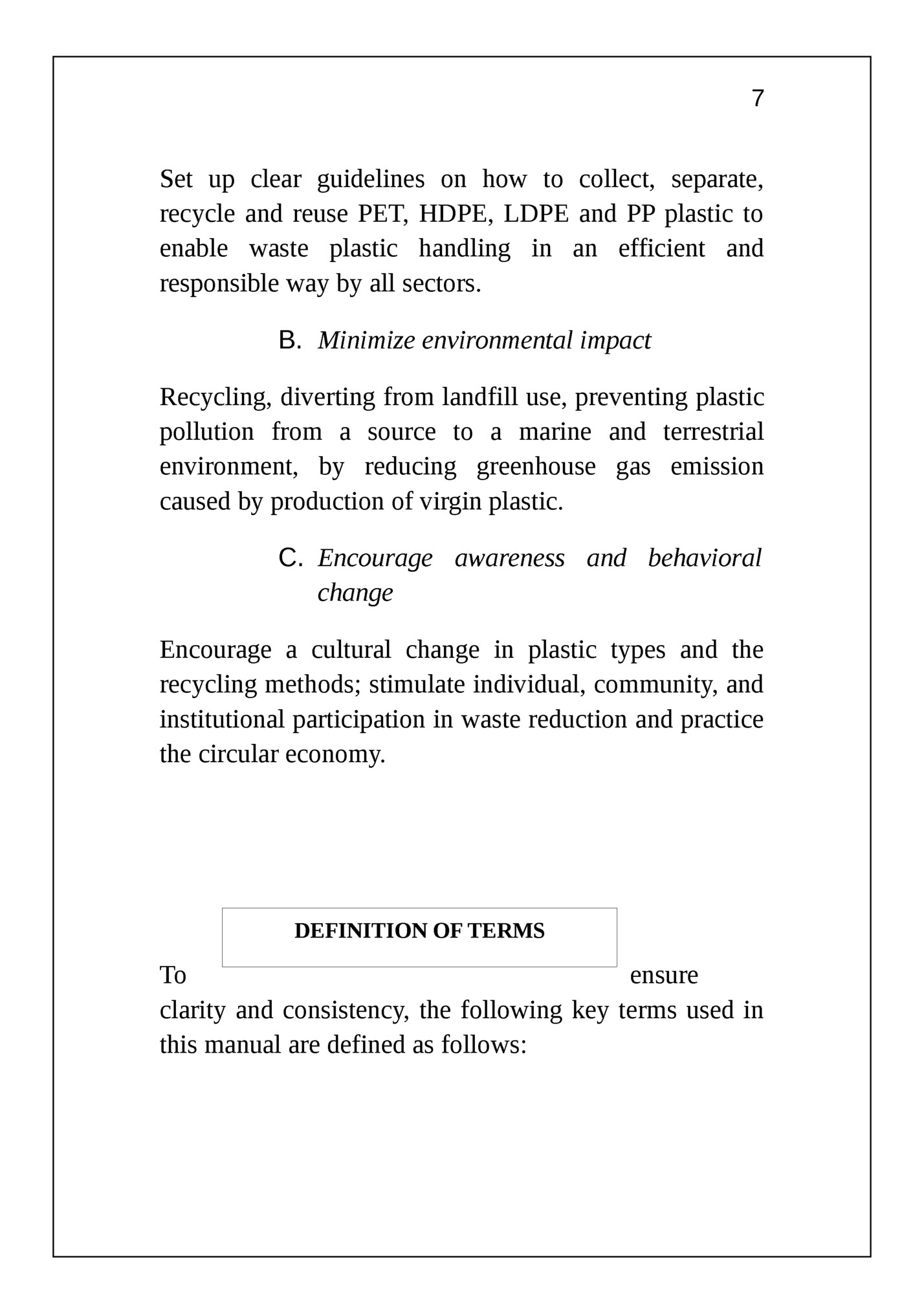
• Circular Economy: An economic model that aims to eliminate waste and pollution, keep products and materials in use, and regenerate natural systems through long-term resource efficiency (US EPA, 2024) • Recycling: The process of collecting, sorting, cleaning, and reprocessing used materials into new products to prevent waste and reduce the consumption of fresh raw materials. • PET (Polyethylene Terephthalate): A type of plastic commonly used for beverage bottles and food containers, known for its strength, transparency, and recyclability. • HDPE (High-Density Polyethylene): A strong, durable plastic used in containers for household products like detergents, milk, and shampoo, as well as in industrial applications. • LDPE (Low-Density Polyethylene): A flexible, lightweight plastic often used in plastic bags, film wraps, and squeeze bottles. • PP (Polypropylene): A versatile plastic used in packaging, automotive parts, reusable containers, and textiles due to its heat resistance and mechanical properties. • Material Recovery Facility (MRF) – A specialized plant that receives, separates, and
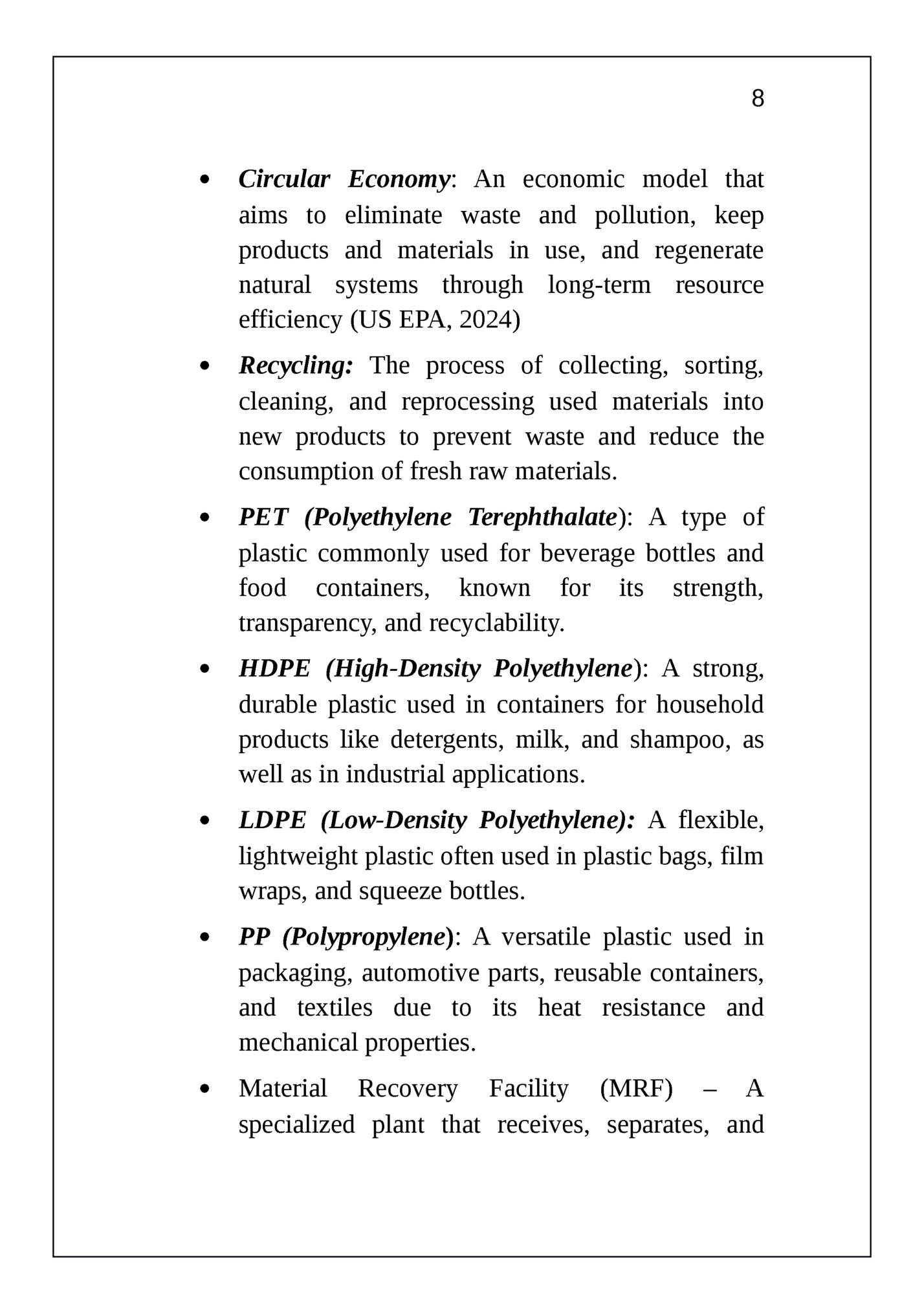
prepares recyclable materials for marketing to end-user manufacturers. Common in waste management and recycling industries. RECYCLING PROCEDURE PROPERTIES PET (Polyethylene Terephthalate) • Optical Properties: PET is known for its excellent clarity and gloss, making it highly transparent. This makes it ideal for applications where product visibility is important, such as water and soda bottles. • Chemical Properties: PET has moderate chemical resistance. It performs well with water and many food substances but can degrade when exposed to strong alkalis and acids over time.

Fleepit Digital © 2021